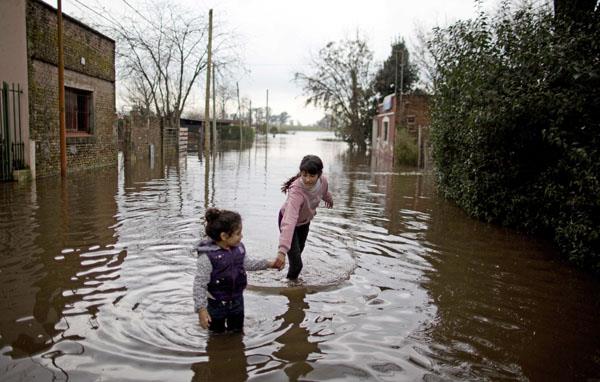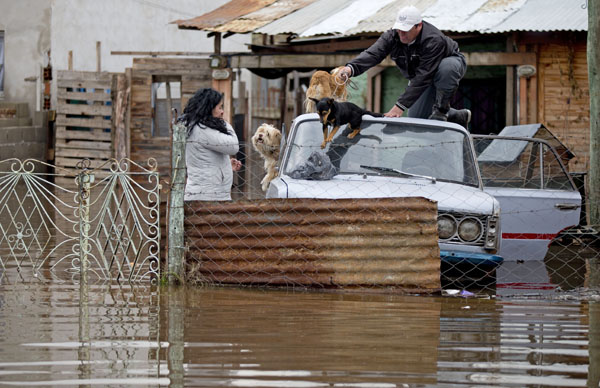Floodwaters continued to wreak havoc in north and northwest of Buenos Aires province yesterday with at least 10,000 evacuated from their homes despite a brief break in bad weather that has caused chaos since last week and has killed at least three people.
Yesterday's respite from the heavy rainfall and high winds failed to abate the widespread flooding affecting residents in Buenos Aires and Santa Fe provinces, with more winds and rain projected for the next few days.
The highest estimates of evacuees continued to rise throughout the day, reaching 10,000 by press time, although the numbers fluctuated as the water mark for rivers increased and decreased and some residents returned home. There were reports that as many as 20,000 people had been affected by the rising waters.
The National Meteorological Service (SNM) forecast strong winds from the south-east over the River Plate and Paraná Delta that will slow the process of floodwaters receding. In addition, another five to 50 millimetres of rainfall has been predicted to fall and tomorrow on the water-logged areas of the east and south-east of Buenos Aires province.
Yesterday the districts of Luján, Tigre, Pilar, San Antonio de Areco, Salto and Tigre the most severely affected urban centres.
"The emergency will continue and we must prepare for that," said Javier Sosa, the head of the Directorate for the Protection and Defence of the Community (ProDeCom) warned yesterday in a statement from the province, adding that the floodwaters for the moment showed no signs of subsiding. "We do not know if (the river) will go much higher, but there will be more days with a lot of accumulated water remaining," he said.
In Luján, which is prone to flooding, the Luján River reached a recent record of 5.41 metres and the water reached the city's iconic Cathedral. The highest measurement for the river is six metres, dating back to 1985.
The Arrecifes River, which is close to Luján, is currently at almost double its regular volume, reaching almost nine metres. There were reports of damage to 5,000 homes in Arrecifes town and more than 1,000 temporary evacuees.
"So far, 350 millimeters of water has accumulated and in some areas, such as Salto, this is a record," said Luciano Timerman, the director of emergency response in the province, referencing the small agricultural town 200 kilometres west of Buenos Aires City where at least 700 residents have been forced to evacuate their homes over the course of the week. Heavily populated La Matanza, meanwhile, had 1,200 evacuees by Tuesday evening.

"It's the third time that I've lost everything and no one has found a solution," said Fabiana Olivera, 43, a Luján resident who took refuge from the flooding at a local shelter with her three children.
In Lujan itself, the iconic double-spired cathedral, a destination of pilgrimage for Catholics across Argentina and beyond, reflected its image down into the floodwaters that surrounded it as residents feared for the religious treasures and architecture housed within.
The current severe flooding witnessed in Buenos Aires province is the worst environmental crisis of its kind since 2013, when even more severe rainfall and floods hit the region leading to 88 recorded deaths and causing more than 500 million pesos in damages across the province.
In response, the provincial government has decided to lift rural and urban taxes on those affected by the floods "without any kind of paperwork."
Security Secetary Sergi Berni has also vowed that "all of the material and human resources are being used to mitigate the situation" and that police and security forces had been deployed to provide assistance.
Santa Fe also hit
A group of around 50 residents from Luján chose to vent their anger at the perceived lack of action from the regional authorities to protect them and their homes from the worst of the floods yesterday, staging a roadblock.
"We're tired of promises," said Fabiana Olivera, who told reporters she expected to be forced to stay in the temporary evacuation shelter near to Luján for at least a month before she and her three children could return home.
Aside from the mass evacuations, the floods forced the cancellation of classes in Luján, Tigre, Mar de Plata and other towns in the province.
Neighbouring Santa Fe province was also plagued by heavy flooding during the week's torrential rain, where continued heavy rainfall is forecast until Thursday morning.
In one of the most dramatic scenes from the flooding so far, a key bridge spanning the Saladillo tributary river in the province, which accommodates the Belgrano-Cargas railway line, collapsed at one section as the floodwaters overwhelmed it over the course of yesterday afternoon, causing the cessation of all rail activity on the line.
Santa Fe's Route 14 highway was also closed by authorities yesterday.




Reader Comments
to our Newsletter